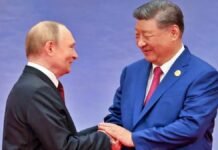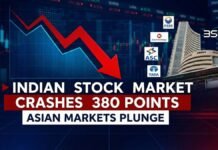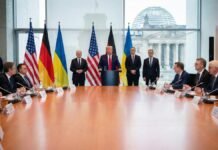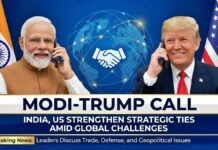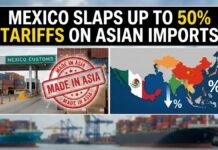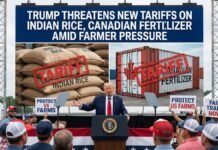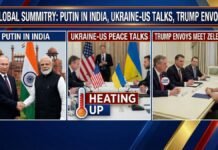
Key Points:
- President Trump announced an additional 100% tariff on all Chinese imports effective November 1, 2025, over and above existing duties
- Export controls on all critical US software to China will also be implemented starting November 1
- The decision came in response to China’s expanded rare earth export restrictions covering 12 of 17 rare earth metals
- US stock markets experienced their worst single-day decline since April 10, with S&P 500 down 2.7%, Dow dropping 879 points, and Nasdaq plummeting 3.6%
- Trump-Xi meeting at APEC summit in South Korea remains uncertain despite Trump saying he “might” still attend
- The current effective tariff rate on Chinese goods stands at 40%, which would more than double with new measures
- Tariffs could be implemented sooner than November 1 if China takes further “aggressive actions”
Washington D.C.: President Donald Trump has unleashed the most aggressive trade action yet against China, announcing a sweeping 100% additional tariff on all Chinese imports in what marks a dramatic escalation of the trade war between the world’s two largest economies. The announcement, made via Truth Social on Friday, October 10, sent shockwaves through global financial markets and pushed US-China relations to a dangerous new precipice.
Unprecedented Tariff Escalation Targets China
The new tariffs, set to take effect on November 1, 2025, will be imposed “over and above any tariff” China is currently paying, effectively more than doubling the existing effective tariff rate of approximately 40% on Chinese goods. Trump also announced that the United States will implement export controls on “any critical software” manufactured in America, a move that could devastate China’s technology sector and semiconductor industry.
The President warned that these measures could be implemented even sooner than November 1, “depending on any further actions or changes taken by China,” creating additional uncertainty for businesses and markets. In his Truth Social post, Trump characterized China’s actions as “extraordinarily aggressive” and accused Beijing of attempting to “hold the world hostage” through its export restrictions.
China’s Rare Earth Weapon Triggers US Response
Trump’s decision came as a direct response to China’s dramatic expansion of export controls on rare earth minerals announced on Thursday. China, which controls approximately 70% of the world’s rare earth supply and 90% of global processing capacity, expanded its restrictions to cover 12 of the 17 rare earth metals, adding promethium, samarium, thulium, europium, and ytterbium to the seven elements already under control since April 2025.
These critical minerals are essential for manufacturing everything from electric vehicles and smartphones to F-35 fighter jets, Virginia-class submarines, Tomahawk cruise missiles, and advanced semiconductor chips. China’s Ministry of Commerce justified the restrictions on national security grounds, stating that certain entities had been transferring Chinese rare earth materials “for military and other sensitive uses”.
According to Trump’s Truth Social statement, China sent an “extremely hostile letter to the World” announcing plans to impose “large-scale Export Controls on virtually every product they make, and some not even made by them,” affecting all countries without exception. Trump described this as “absolutely unheard of in international trade” and a “moral disgrace”.
Global Markets Plunge on Trade War Fears
Financial markets experienced their most severe single-day decline in six months following Trump’s announcement. The S&P 500 plummeted 2.7%, shedding 183 points to close at 6,553, while the Dow Jones Industrial Average tumbled 879 points or 1.8%. The tech-heavy Nasdaq suffered the worst losses, dropping 3.6% as investors fled technology stocks, particularly vulnerable to trade tensions.
Hong Kong’s Hang Seng Index fell 4%, reflecting broader concerns across Asian markets about the escalating trade conflict. After-hours trading saw additional declines, with shares of major technology companie,s including Nvidia, Tesla, Amazon, and Advanced Micro Devices each falling more than 2%.
Wall Street analyst Adam Crisafulli of Vital Knowledge noted that while “investors still think the tit-for-tat between the U.S. and China these last few days is mostly posturing,” trade-related risks have “certainly risen after being dormant for the last several weeks”. The S&P 500 and Nasdaq posted their largest single-day percentage drops since April 10, with the S&P 500 suffering its worst weekly loss since May.
Consumer Prices Set to Surge Under New Tariffs
The new tariff regime threatens to significantly increase the burden on American consumers, who are already grappling with elevated prices from earlier tariff rounds. Wells Fargo Economics analysis indicates that the additional 100% tariff would more than double the current effective tariff rate of 40% on Chinese imports, potentially pushing consumer prices substantially higher on electronics, toys, household appliances, and other goods heavily sourced from China.
Consumer prices have already been affected by existing tariffs throughout 2025, with increases noted in clothing (0.5%), audio and video equipment, motor vehicle parts (0.6%), and new cars (0.3%). Grocery prices surged 0.6% in recent months, marking the most substantial monthly increase since August 2022. Major retailers, including Target, Walmart, and brands like Adidas, have already warned about potential price increases due to tariff pressures.
Economists warn that the “middle-class squeeze from tariffs is here,” with necessities including food, gas, clothing, and shelter all experiencing significant cost increases. The situation could worsen in the coming months as more tariff costs are passed along to American consumers, creating stagflation concerns for the Federal Reserve as it balances inflation control with employment and growth objectives.
Trump-Xi Meeting Hangs in Balance
The escalating trade tensions have cast serious doubt over a planned meeting between Trump and Chinese President Xi Jinping at the Asia-Pacific Economic Cooperation (APEC) summit in Gyeongju, South Korea, scheduled for October 31-November 1. Trump initially stated on Truth Social that “there seems to be no reason” to meet with Xi, suggesting he might cancel the highly anticipated discussion.
However, Trump later softened his stance during a White House press availability, telling reporters, “I don’t know that we’re going to have it, but I’m going to be there regardless. So I would assume we might have it”. This created significant uncertainty about whether the meeting, which would be the first face-to-face discussion between the two leaders since 2019, would proceed as planned.
Beijing never officially confirmed the meeting, and the world now watches closely for China’s next move, which will determine whether diplomatic channels remain open or if the trade war escalates further. Trump acknowledged that the November 1 implementation date was chosen deliberately: “That’s why I made it Nov. 1st. We’ll see what happens,” suggesting room for negotiation if China backs down from its rare earth restrictions.
Technology Sector Faces Dual Threats
The announcement of export controls on “any critical software” represents a potentially devastating blow to China’s technology ambitions and semiconductor industry. This measure, combined with the 100% tariff increase, creates a dual threat that could significantly disrupt China’s tech sector, which relies heavily on American software for advanced manufacturing, artificial intelligence development, and semiconductor production.
The restrictions come at a particularly sensitive time as China attempts to achieve self-sufficiency in critical technologies amid ongoing concerns about supply chain vulnerabilities. Major US technology companies saw their shares decline sharply both during regular trading and after hours, reflecting investor concerns about reduced access to the Chinese market and potential retaliatory measures from Beijing.
Global Supply Chain Disruption Looms
The escalating trade war threatens to create severe disruptions in global supply chains, potentially affecting industries far beyond the immediate US-China bilateral relationship. China’s rare earth restrictions already impact multiple sectors globally, and the addition of 100% US tariffs on Chinese goods could force multinational companies to fundamentally restructure their manufacturing and sourcing strategies.
Businesses are already bracing for impact, with contrasting sentiments emerging among manufacturers. Some domestic US producers expect improved demand as tariffs make Chinese alternatives more expensive, while others worry about rising costs for Chinese inputs that have limited alternatives. The services sector has also expressed concerns about potential cost increases that could affect investment and employment decisions.
The trade conflict has moved quickly throughout 2025, with periods of escalation followed by temporary truces, only to reignite over strategic issues like rare earth access. The current situation represents one of the most severe escalations yet, with both sides wielding their most powerful economic weapons: China’s control over critical minerals and America’s massive consumer market.






